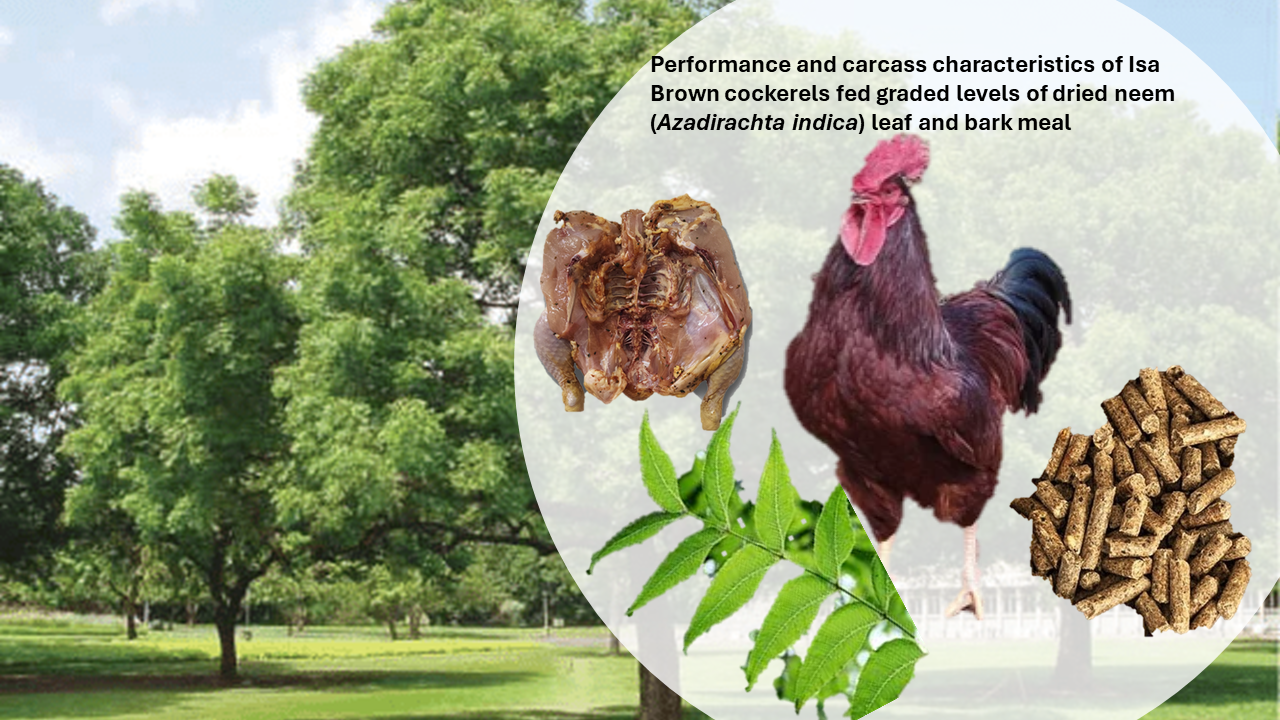Performance and carcass characteristics of Isa Brown cockerels fed graded levels of dried neem (Azadirachta indica) leaf and bark meal
DOI:
https://doi.org/10.14295/bjs.v3i7.614Keywords:
poultry, neem leaf, neem bark, carcass, cockerelAbstract
The use of synthetic additives has some safety risks, residues, and consumer dissatisfaction. This has led Poultry farmers to prefer the rearing of healthy birds using natural growth and health-promoting natural feed additives. Azadirachta indica (neem leaf and bark) has good potential as feed additives. This study assessed the effect of graded levels of neem leaf and bark meal on the performance and carcass characteristics of ISA Brown cockerels. The study used two hundred and seventy (270) day-old ISA Brown strain cockerels. The birds were randomly allotted to nine dietary treatments of thirty birds each, replicated thrice with ten birds per replicate. The treatments were 0 g Neem leaf meal (NLM) and Neem bark meal (NBM) as control, 2.5 g, 5.0 g, 7.5 g, and 10.0 g NLM/kg feed-1, 2.5 g, 5.0 g, 7.5 g and 10.0 g NBM/kg-1 feed in a Completely Randomized Design. Birds were fed the experimental diets from 1st week to 20th week of age. Daily feed intake (DFI), Daily Weight Gain (WG), Feed Conversion Ratio (FCR), and carcass weight were evaluated. Data were analyzed using the General Linear Model at p = 0.05. Cockerel chickens fed 2.5 g/kg-1 NLM exhibited significantly higher Final Weight (FW), DWG, and ADG during the starter phase compared to the control. In the grower phase, birds fed 5.0 g/kg-1 Neem Bark Meal (NBM) showed significantly heavier FW, DWG, and ADG. Carcass features like wings, thighs, drumsticks, back, breast, head, and neck were similarly affected. At the finisher phase, neem bark meal up to 5.0 g/kg-1 of feed enhanced growth performance. Based on the outcomes of this study, the following conclusions can be drawn: Feeding cockerels with neem bark meal at a rate of up to 5.0 g/kg-1 of feed improved final body weight and resulted in a better feed conversion ratio. However, supplementation with 7.5 g/kg-1 neem leaf meal enhanced carcass characteristics in cockerel chickens.
References
Agarwal, D. P. (2002). Biological activities and medicinal properties of neem (Azadirachta indica). Current Science, 82(11), 1336-1345. https://www.jstor.org/stable/24106000
Angelakis, E., Merhej, V., & Raoult, D. (2013). Related actions of probiotics and antibiotics on gut microbiota and weight modification. The Lancet Infectious Diseases; 13(10), 889-899. https://doi.org/10.1016/S1473-3099(13)70179-8 DOI: https://doi.org/10.1016/S1473-3099(13)70179-8
Bishnu, J., Sunil, L. & Anuja, S. (2009). Antibacterial property of different medicinal plants: Azadirachta indica, Cinnamomum zeylanicum, Xanthoxylum armatum and Origanum majorana. Kathmandu University. Journal of Science and Engineering Technology, 5, 143-150. DOI: https://doi.org/10.3126/kuset.v5i1.2854
Biu, A. A., Yusufu, S. D., & Rabo, J. S. (2009). Phytochemical screening of Azadirachta indica (Neem) (Meliaceae) in Maiduguri, Nigeria. Bioscience Research Communications, 21(6), 281-283.
Bonsu, F. R. K, Kagya-Agyemang, J. K., Kwenin, W. K. J. & Zanu, H. K. (2012). Medicinal response of broiler chickens to diets containing Neem (Azadirachta indica) leaf meal, haematology and meat sensory analysis. World Applied Science Journal, 19(6), 800-805.
Cherkupally, R, Kota, S. R., Amballa, H., & Reddy, B. N. (2017). In vitro antifungal potential of plant extracts against Fusarium oxysporum, Rhizoctonia solani and Macrophomina phaseolina. Annals of Plant Sciences, 6(9), 1676-1680. http://dx.doi.org/10.21746/aps.2017.9.2 DOI: https://doi.org/10.21746/aps.2017.9.2
Chukwuemeka, N. (2017). Agriculture diary: Cockerel production, type of cockerel breeds, benefits of Cockerel.http://www.agriculturediary.com/cockerel production-type-cockerel-breeds benefits cockerel
Durani, F. R., Chand, N., Jan, M., Sultan, A., Durani, Z., & Akhter, S. (2008). Immunomodulatory and growth promoting effects of neem (Azadirachta indica) leaves infusion in broiler chicks. Sarhad Journal of Agriculture, 24(4), 655-659.
El-Far, A. H., Ahmed, H. A., & Shaheen, H. M. (2016) Dietary supplementation of Phoenix dactylifera seeds enhances performance, immune response, and antioxidant status in broilers. Oxidative Medicine and Cellular Longevity. https://doi.org/10.1155/2016/5454963 DOI: https://doi.org/10.1155/2016/5454963
Esonu, B. O., Emenalom, O. O., Udedibie, A. B. I., Anyanwu, G. A., Madu, U., & Inyang, A. O. (2005). Evaluation of neem (Azadirachta indica) leaf meal on performance, carcass characteristics and egg quality of laying hens. International Journal of Agricultural Development, 6, 208-212. DOI: https://doi.org/10.4314/ijard.v6i1.2611
Esonu, B. O., Opara, M. N., Okoli, I. C., Obikaonu, H. O., Udedibie, C., & Iheshiulor, O. O. M. (2006). Physiological responses of laying birds to Neem (Azadirachta indica) leaf meal-based diets, body weight, organ characteristics and hematology. Online Journal of Health and Allied Sciences, 2(4). http//www.ojhas.org/issue 18/2006-2-4.htm 2006.
Islam, M. K., Kabir, S. M. L., Haque, A., Sarker, Y. A., & Sikder, M. H. (2018). Molecular detection and characterization of Escherichia coli, Salmonella spp. and Campylobacter spp. isolated from broiler meat in Jamalpur, Tangail, Netrokona and Kishoreganj districts of Bangladesh. Africa Journal of Microbiology Research, 12(32), 761-770. https://doi.org/10.5897/AJMR2018.8945 DOI: https://doi.org/10.5897/AJMR2018.8945
Islas, J. F., Acosta, E., G-Buentello, Z., Delgado-Gallegos, J. L., Moreno-Treviño, M. G., Escalante, B., & Moreno-Cuevas, J. E. (2020). An overview of neem (Azadiractha indica) and its potential impact on health. Journal of Functional Foods, 74, 104171. https://doi.org/10.1016/j.jff.2020.104171 DOI: https://doi.org/10.1016/j.jff.2020.104171
Jawad Z., Younus, M., Rehman, M. U., Munir, R., Maqbool, A., Shahzad, W., Masood, S., & Muhammad, K. (2014). Effect of Azadirachta indica on the hepato-renal functions in broilers chickens. Journal of Animal and Plant Science, 24(4), 1012-1018.
Kale, B. P., Kothekar, M. A., Tayade, H. P., Jaju, J. B., & Mateenuddin, M. (2003). Effect of aqueous extract of Azadirachta indica leaves on hepatotoxicity induced by antitubercular drugs in rats. Indian Journal of Pharmacology, 35(3), 177-180.
Ojediran, T. K., Adisa, Y. A., Yusuf, S. A., & Emiola, I. A. (2014a). Nutritional evaluation of processed Jatropha curcas kernel meals: Effect on growth performance of broiler chicks. Journal of Animal Science Advances 4(11), 1110-1121. https://doi.org/10.5455/jasa.20141115115449 DOI: https://doi.org/10.5455/jasa.20141115115449
Ojediran, T. K., & Emiola, I. A. (2014b). Toxicological impact of processed Jatropha curcas kernel meals on the gut morphology and kidney of broiler chicks. Journal of Animal Science Advances, 4(11), 1122-1131. https://doi.org/10.5455/jasa.20141112084436 DOI: https://doi.org/10.5455/jasa.20141112084436
Ojediran, T. K., Ogunmola, B. T., Ajayi, A. O., Adepoju, M. A., Odelade, K., & Emiola, I. A. (2016). Nutritive value of processed dietary fungi treated Jatropha curcas L. kernel meals: voluntary intake, growth, organ weight and hepatic histology of broiler chicks. Tropical Agriculture (Trinidad), 93(2), 101-110. https://doi.org/0041-3216/2016/020101-10
Ojediran, T. K., Oyebode, O. O., Amao, O.A. Shittu, M. D., & Odedoyin, O. (2017). Serum biochemistry, organ weight, carcass characteristics, organoleptic properties and villi morphometry of nera black cocks fed varying levels of Moringa oleifera leaf meal. Scientific Papers: Animal Science and Biotechnologies, 50(2), 16-23. https://www.spasb.ro/index.php/public_html/article/view/1069
Ojediran T. K., & Emiola, I. A. (2018). Effect of processing and level of inclusion of processed-fermented Jatropha curcas (L) kernel meals on the performance of starter broiler chicks. Tropical Agriculture (Trinidad) 95(1), 55-66. https://doi.org/0041-3216/2018/010055-12
Ojediran, T. K., Ganiyu, B., Muhammed, A., & Emiola, I. A. (2022). Egg production, economic indices, and external and internal egg quality parameters of laying Japanese quails (Coturnix japonica) fed palm (Elaeis guineensis) kernel cake. Animal Sciences and Genetics, 18(2), 1-11. https://doi.org/10.5604/01.3001.0015.8489 DOI: https://doi.org/10.5604/01.3001.0015.8489
Oladunjoye, I. O., Ojediran, T. K., Aringbangba, O. S., Akinrinade, O. S., & Opakunle, O. G. (2014). Effects of inclusion level and lenght of fermentation on the utilization of Jatropha (Jatropha curcas) seed cake by broiler chickens. International Journal of Current Microbiology and Applied Sciences, 3(7), 44-54.
Onyimonyi, A., Adeyemi, O., & Okeke, G. C. (2009). Performance and economic characteristics of broilers fed varying dietary levels of neem leaf meal (Azadirachta indica). International Journal of Poultry Science, 8. https://doi.org/10.3923/ijps.2009.256.259. DOI: https://doi.org/10.3923/ijps.2009.256.259
Sarker, S. K., Mostofa, M., Akter, F., Rahman, M. M. and Sultana, M. R. (2014). Effects of aqueous extract of neem (Azadirachta indica) leaves as growth promoter and anti-colibacillosis in broilers. Bangladish Journal of Animal Science, 43(2), 138-141. DOI: https://doi.org/10.3329/bjas.v43i2.20715
Sarker, Y. A, Hasan, M. M., Paul, T. K., Rashid, S. Z., Alam, M. N., & Sikder, M. H. (2018). Screening of antibiotic residues in chicken meat in Bangladesh by thin layer chromatography. Journal of Advance Veterinary Animal Research, 5(2), 140-145. DOI: https://doi.org/10.5455/javar.2018.e257
Sarker, Y. A., Rashid, S. Z., Sachi, S., Ferdous, J., Das Chowdhury, B. L., Tarannum, S. S., & Sikder, M. H. (2020). Exposure pathways and ecological risk assessment of common veterinary antibiotics in the environment through poultry litter in Bangladesh. Journal of Environental Science and Health, 55(12), 1061-1068. https://doi.org/10.1080/03601234.2020.1816090 DOI: https://doi.org/10.1080/03601234.2020.1816090
Talukder, S., Hasan, M. M., Noman, Z. A., Sarker, Y. A., Paul, T. K., & Sikder, M. H. (2017). Effect of dietary supplementation of ginger extract on growth, carcass characteristics and haematological parameters in broilers. Asian Journal of Medical Biology Research, 3(2), 211-215. https://doi.org/10.3329/ajmbr.v3i2.33571 DOI: https://doi.org/10.3329/ajmbr.v3i2.33571
Tipu, M. A., Pasha, T. N., & Ali, Z. (2002). Comparative effect of salinomycine sodium and neem fruit (A. indica) as feed additive anticoccidials in broilers. International Journal of Poultry Science, 1(4), 91-93. http://dx.doi.org/10.3923/ijps.2002.91.93 DOI: https://doi.org/10.3923/ijps.2002.91.93
Ubua, J. A., Ozung, P. O., & Inagu, P. G. (2019). Dietary inclusion of neem (Azadirachta indica) leaf meal can influence growth performance and carcass characteristics of broiler chicken. Asian Journal of Biological Sciences, 12(2), 180-186. https://scialert.net/abstract/?doi=ajbs.2019.180.186 DOI: https://doi.org/10.3923/ajbs.2019.180.186

Downloads
Published
How to Cite
Issue
Section
License
Copyright (c) 2024 Oyetoro Blessing Abiola, Adedeji Olusegun Stephen, Ojediran Taiwo Kayode, Rom-Kalilu Fiwasade Adejoke, Daniel Modupe Blessing

This work is licensed under a Creative Commons Attribution 4.0 International License.
Authors who publish with this journal agree to the following terms:
1) Authors retain copyright and grant the journal right of first publication with the work simultaneously licensed under a Creative Commons Attribution License that allows others to share the work with an acknowledgement of the work's authorship and initial publication in this journal.
2) Authors are able to enter into separate, additional contractual arrangements for the non-exclusive distribution of the journal's published version of the work (e.g., post it to an institutional repository or publish it in a book), with an acknowledgement of its initial publication in this journal.
3) Authors are permitted and encouraged to post their work online (e.g., in institutional repositories or on their website) prior to and during the submission process, as it can lead to productive exchanges, as well as earlier and greater citation of published work.




